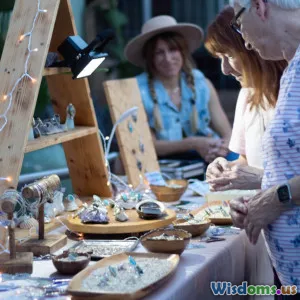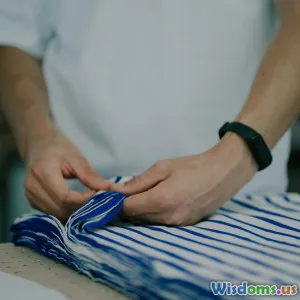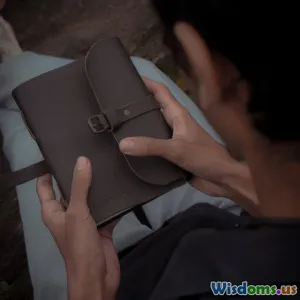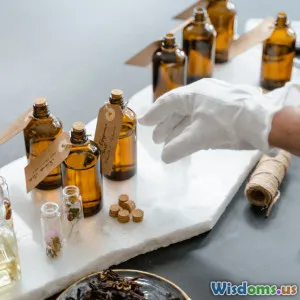
10 Common Mistakes Beginners Make When Handcrafting Jewelry at Home
7 min read Discover 10 common pitfalls new jewelry makers face and learn how to avoid them for flawless handcrafted creations at home. (0 Reviews)
10 Common Mistakes Beginners Make When Handcrafting Jewelry at Home
Handcrafting jewelry can be a deeply rewarding creative outlet, blending art and technique in beautiful wearable forms. However, for beginners diving into this craft at home, the journey can be riddled with challenges that lead to frustration and wasted time, materials, or money. If you've ever found your necklaces breaking, beads scattering, or designs just not quite coming together, you’re not alone.
In this in-depth guide, we explore the 10 most common mistakes novices make in their jewelry-making ventures—and, more importantly, how to avoid them. Understanding these errors is key to nurturing skill, confidence, and craftsmanship in this intricate art.
1. Skipping the Planning Phase
Jumping straight into materials without a clear design plan often leads to mismatched styles, weak structures, or unsatisfactory results. Successful handmade jewelry begins with thoughtful sketching or mood boarding.
Example: A beginner eager to craft a bracelet picks charms and beads haphazardly, resulting in an unbalanced, heavy piece that wears uncomfortably.
Pro Tip: Start with simple design outlines and consider functionality—how will the jewelry fit, move, and feel? This larger perspective ensures cohesiveness and comfort.
2. Using Inadequate or Low-Quality Tools
Investing in quality tools is crucial. Beginner-friendly jewelry pliers, wire cutters, and bead boards may cost more upfront but prevent strong headaches and wasted materials.
According to jewelry expert Jane Dubois, "Using the right, well-made tools not only increases precision but reduces hand fatigue and accidents."
Common mistake: Using household scissors to cut wire often leads to jagged ends that unravel or injure.
3. Choosing the Wrong Materials for the Project
Beginners might pick materials too quickly, not matching wire gauges to bead hole sizes or using delicate metals for weight-bearing components.
For instance, using flimsy craft wire for weighty glass beads can cause your entire piece to snap under stress.
Tip: Research and source materials suited to your design needs; necklaces supporting a pendant require sturdier chains or wires compared to simple bead bracelets.
4. Neglecting Proper Measurements and Sizing
One of the fastest ways to render your piece unusable is poor sizing. Whether it’s a ring, bracelet, or necklace, incorrect length or circumference can make jewelry uncomfortable or impossible to wear.
Insight: Experienced jewelers often measure wrist sizes multiple times and allow extra length for clasps or stretch.
Beginner errors include cutting wire too short or overestimating bead sizes, leading to empty gaps or overly tight jewelry.
5. Overlooking the Importance of Secure Closures
A tiny loose jump ring or a poorly crimped bead can unravel an entire necklace.
Closures are security points. If neglected, they cause premature breakage.
Example: Failing to close jump rings fully can lead to beads slipping off, frustrating creators and wearers alike.
Use two pairs of pliers to close jump rings properly or learn crimping techniques to strengthen connections.
6. Underestimating Patience and Practice
Handcrafting jewelry demands meticulousness. Rushing leads to crooked wire loops or uneven bead placement.
Case: Sarah, a novice, spent 20 minutes making a wire-wrapped pendant; rushing led to kinks and breakage. After practicing and slowing down, her pieces became much cleaner and durable.
7. Inadequate Workspace Setup
Cluttered spaces, poor lighting, and unstable surfaces trip up many beginners.
A dedicated, tidy craft area aids visual clarity and ease of movement, decreasing mistakes.
Expert advice: Position magnifying tools and lighting to reduce eye strain, use bead boards to organize components preventing loss.
8. Relying Solely on Tutorials Without Understanding Techniques
Watching videos is helpful, but mindless replication limits skill development.
Comprehension of fundamentals like wire wrapping angles, bead threading order, and knot security leads to better improvisation and error correction.
Invest in workshops or consider books by renowned jewelry artists to deepen knowledge.
9. Ignoring Material Care Instructions
Not all jewelry materials behave similarly. For example, copper tarnishes without proper sealing; leather can deteriorate unless conditioned.
Ignoring these facts causes premature fading or breakage.
Recommendation: Learn about your supplies—for instance, sealing with clear nail polish or specific jewelry coatings extends lifespan.
10. Failing to Experiment and Explore Creative Freedom
While avoiding errors is important, don’t be so rigid you stifle creativity.
Experiment with textures, color blends, and non-traditional materials.
Failing here leads to uninspired work and discouragement.
Great jewelry makers embrace mistakes as opportunities for growth.
Conclusion
Handcrafting jewelry at home is an engaging journey that mixes art, science, and skill. The beginner mistakes outlined above—from poor planning and tool use to neglecting closures and workspace setup—are common, but completely avoidable with awareness and effort.
By approaching your craft methodically, investing in quality tools and materials, practicing patience, and fostering creative exploration, you’ll create durable, stunning jewelry that reflects your unique vision.
Whether you aspire only to personal satisfaction or commercial success, clearing these hurdles paves the way to mastery.
Your next handcrafted treasure awaits!
Ready to elevate your jewelry game? Start with a tidy workstation today and sketch your design ideas before picking up your tools.
Rate the Post
User Reviews
Popular Posts



















